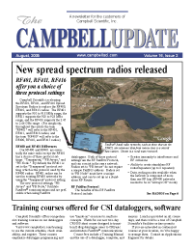To better understand the direction of telemetry technology as it pertains to data retrieval using Campbell Scientific dataloggers, perhaps it is useful to consider the changes that we see occurring broadly in telecommunications. It used to be that all the service we needed or even thought we needed from a phone company was a dial tone. Whether for voice or for data, when we want access, we lift the receiver, wait for a dial tone, and then dial a number that addresses a remote phone or modem, which when answered, begins a two-way dialog that completely occupies all of the telemetry resource represented by the simultaneously connected ends and all points in between.
Ethernet and similar technologies introduced a means of simultaneous multi-point connection. This advance in communication electronics was leveraged through digital (and optical) electronics by organizing information into packets, each with a header containing a destinationaddress that could then be routed and switched with the flexibility of different possible communication paths between source and destination. Internet Protocol (IP) became the standard of packet organization, routing, and decoding. Sophisticated switches and routers automateand optimize the passing of packets with such speed that reconstituted voice over IP sounds very nearly like a dedicated circuit. To the extent that packets in phone networks may be distinguished among voice, video, and data, for most users, data packets may be given a lower priority as in the case of text messaging on cellular phones. In the long run, such network architecture should be able to deliver data packets with greater reliability and at less cost.
For many years, Campbell Scientific has invested in technologies that improve the capability of data retrieval while maintaining compatibility with changes that occur in the telecommunications industry. In the U.S., different providers in the cellular market use competing standards. CSI now offers a modem for cellularnetworks using GPRS (General Packet Radio Service) technology. Other cellular networks in the U.S. use CDMA (Code Division Multiple Access) digital cellular comstandards that we are also able to access. Current and future efforts will improve our ability to deliver SMS (Short Message Service) packets over cellular networks. Our full range of telemetry products is explained at www.campbellsci.com/communications. Campbell Scientific affiliates offer telemetry peripherals suitable for their locale.
We have also been able to adopt some of the ideas used in broader networking to improve capabilities in our own private networks. This can be seen in the CR1000 with PAKBUS® routing capability. A significant improvement in the RF401 over the RF400 (cover article) is the implementation of PAKBUS routing capability. The RF401 takes advantage of a packet-switched architecture to automatically route packets to the desired destination, and to automatically retry in the event a packet doesn't make it. Diagnostics are improved to help identify the fault if packets are not getting through.
Campbell Scientific is committed to support you with the data telemetry means that best matches your need. Whether the technology is Internet, radio, or land-line based, it is likely we have the means to do the job.

